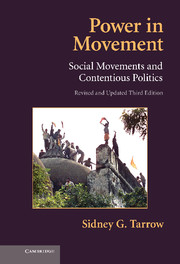Book contents
- Frontmatter
- Contents
- List of Figures
- List of Tables
- Preface
- Acknowledgments
- Introduction
- 1 Contentious Politics and Social Movements
- PART I THE BIRTH OF THE MODERN SOCIAL MOVEMENT
- PART II POWERS IN MOVEMENT
- 5 Acting Contentiously
- 6 Networks and Organizations
- 7 Making Meanings
- 8 Threats, Opportunities, and Regimes
- PART III DYNAMICS OF CONTENTION
- Conclusions: The Future of Social Movements
- Sources
- Index
- Titles in the series
7 - Making Meanings
- Frontmatter
- Contents
- List of Figures
- List of Tables
- Preface
- Acknowledgments
- Introduction
- 1 Contentious Politics and Social Movements
- PART I THE BIRTH OF THE MODERN SOCIAL MOVEMENT
- PART II POWERS IN MOVEMENT
- 5 Acting Contentiously
- 6 Networks and Organizations
- 7 Making Meanings
- 8 Threats, Opportunities, and Regimes
- PART III DYNAMICS OF CONTENTION
- Conclusions: The Future of Social Movements
- Sources
- Index
- Titles in the series
Summary
DEMOLISHING A MOSQUE
At 11 am on December 6, 1992, in the holy city of Ayodhya, in the Indian state of Uttar Pradesh, a group of young men carrying hammers and iron rods erupted into the Babri mosque. This mosque, which was built during the Moghul (i.e., Muslim) domination of India, stood on land that had supposedly held a temple to the Hindu god Ram. The young men, or kar sevaks, were volunteers loosely affiliated with three Hindu nationalist groups: the Rashtriya Swayamseveak Sangh (RSS), the Vishwa Hindu Parishad (VHP), and the rapidly rising Bharatiya Janata Party (BJP), which had gained almost a third of the votes in the 1991 elections and governed the state (Jaffrelot 1996: 558). Although Hindu nationalism was on the rise all over India, it was particularly volatile here in the North (Brass 1974, Jaffrelot 1996, Mehta 1993).
By lunchtime, as the police stood by, the mosque's idols, collection boxes, and portraits were carried off by the crowd. By 2:55 pm, the left dome of the building had caved in; by 4:35, the right one fell too, and the central one followed a few minutes later. “Even before that,” continues Christophe Jaffrelot, “Muslims were attacked in Ayodhya town and many houses whose inhabitants had fled were set ablaze.” After the demolition was complete, the kar sevaks constructed a temporary temple in which Hindu images were placed (p. 455).
- Type
- Chapter
- Information
- Power in MovementSocial Movements and Contentious Politics, pp. 140 - 156Publisher: Cambridge University PressPrint publication year: 2011
- 1
- Cited by

